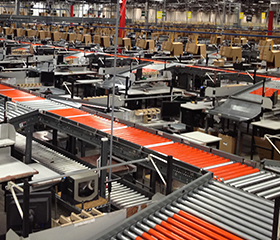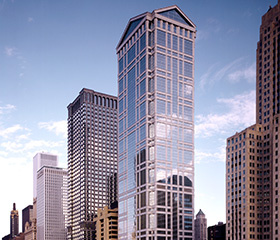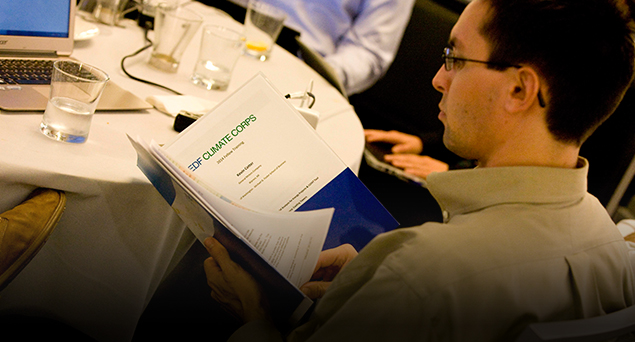Environmental Defense Fund is working to share scalable solutions to tough energy management challenges.
Since 2008, our EDF Climate Corps fellows have engaged with hundreds of leading organizations to improve their energy management efforts. What we’ve seen is that the barriers to smart energy management are not unique to these companies.
The case studies below contain lessons learned and best practices that other organizations can replicate in their own facilities. While every organization operates differently, the findings in these case studies are relevant to many others looking to cut costs and emissions.
IKEA

Building a Sustainable Supply Chain
For IKEA it isn’t just about making affordable furniture, it’s about making products in ways that are good for people and the planet. That’s why Stefan Karlsson, the Sustainability Compliance Manager for IKEA Purchasing Service (China) Co., Ltd. was interested in finding ways to help green IKEA’s global supply chain. But with over 300 suppliers in China alone, this isn’t easy. Since 2016, Karlsson has brought on board four EDF Climate Corps fellows to help with IKEA’s Coal Removal Project—reducing coal use as a direct source from the energy portfolios of local supplier factories in China. The secret to their success? Working with China’s policies, making the business case and creating change at scale.
Ares Management

Doing Well by Doing Good
Ares Management, L.P. (Ares) Private Equity Group (PEG) has a history of successfully investing in leading companies with attractive growth profiles, in part, due to its long-standing strategy of collaboratively creating value with portfolio company management. Energy-related value creation initiatives within the PEG’s portfolio of companies could also fit into this collaborative framework. Ares chose to explore EDF Climate Corps as an avenue for achieving this goal.
Starwood Hotels & Resorts Worldwide, Inc.

Accelerating Sustainability Across Portfolios
In 2009, Starwood Hotels & Resorts Worldwide, Inc announced mandatory sustainability goals across its entire portfolio, regardless of whether the property is owned, managed or franchised. Wanting to go further, Starwood turned to EDF Climate Corps for help with creating a performance measurement tool, which would allow facility managers to better understand, visualize and monitor actual energy and water reduction performance of its more than 1,270 properties. Aside from giving each property huge monetary savings, the tool helps to reduce labor costs, facilitate more informed decision-making and enable leaks to be fixed more quickly.
The Volvo Group

Energy Savings: Turning One Win Into Many
Having appointed “environmental care” as a core value, The Volvo Group set out to increase energy efficiency and become the world leader in sustainable transport solutions. After setting ambitious emissions reduction goals, the company turned to partnerships (EDF Climate Corps, the Department of Energy, Siemens) for guidance on how best to achieve them. The result was an energy management model—initially a pilot project at one manufacturing plant—that was scaled across all eight of the company’s facilities with the potential to be replicated in new locations. With new reduction goals on the horizon, Volvo is continuing to expand its partnerships, including more EDF Climate Corps fellows and the Department of Energy’s Better Plants program.
City of Hoboken

Microgrids Made Easier
In 2012, the City of Hoboken was devastated by Superstorm Sandy – 90 percent of the city lost power for almost two weeks. Vowing “never again,” the city is determined to set up a microgrid to provide back-up power to 55 critical buildings including fire stations, pharmacies and low-income and senior housing. 2015 EDF Climate Corps fellow Devashree Ghosh created a toolkit to help Hoboken establish and maintain a resilient, sustainable microgrid, and since cities up and down the east coast look just like Hoboken, it’s a toolkit that can be used by city managers everywhere.
adidas Group

Conveyor Belt to Energy Savings
In 2014, adidas Group engaged with EDF Climate Corps to evaluate energy savings in its Spartanburg, South Carolina distribution center. Columbia University graduate student, Eric Shrago was assigned the case, and he investigated possible energy savings from the Material Handling Equipment. From his observations, the adidas Group created a set of guidelines for new distribution center construction, and while every distribution center is different, Eric’s findings have relevance across the warehousing and logistics industry.
JLL

Driving Energy Efficiency in Class A Buildings
77 West Wacker Drive, the old headquarters for United Airlines, was one of the first buildings to join EDF's Chicago Building Energy Initiative. EDF Climate Corps fellow Karan Gupta is working with real estate giant Jones Lang LaSalle to take a deep dive into energy efficiency at this 50-story office building. Together, they have identified an energy reduction goal of 5M kWh by 2018; 2M kWh of which has been uncovered during the 2014 fellowship. In addition, they are leading the way in demand response and piloting a tenant engagement project to change energy usage in the building.
Denver Housing Authority

Public Housing: Let Your Roof Make it Rain
The Housing Authority of the City and County of Denver (DHA) wanted to expand its portfolio of renewable energy sources with little up-front costs, so it engaged with several partners to establish a solar Power Purchase Agreement (PPA). Unlike typical solar PPAs, the DHA project was installed across 387 different existing buildings, and the project actually generates revenue for the housing authority because of the lease agreements on its roof space.
Urban Innovations

ROI of Energy Efficiency in Class B Buildings
Urban Innovations is a fully integrated real estate investment firm, which controls 11 commercial properties in Chicago's River North neighborhood with more than 180 tenants. EDF Climate Corps fellow Michael Perry developed an Excel-based tool that identified applicable rebate information and calculated cost-savings from upgrading to more energy efficient systems and equipment. Through the use of this tool, Urban Innovations identified annual reductions of over 990,000 kilowatt hours in electricity usage, over $70,000 in annual cost-savings, over $72,000 in immediate rebates, and over 846 metric tons in greenhouse gas reductions.
